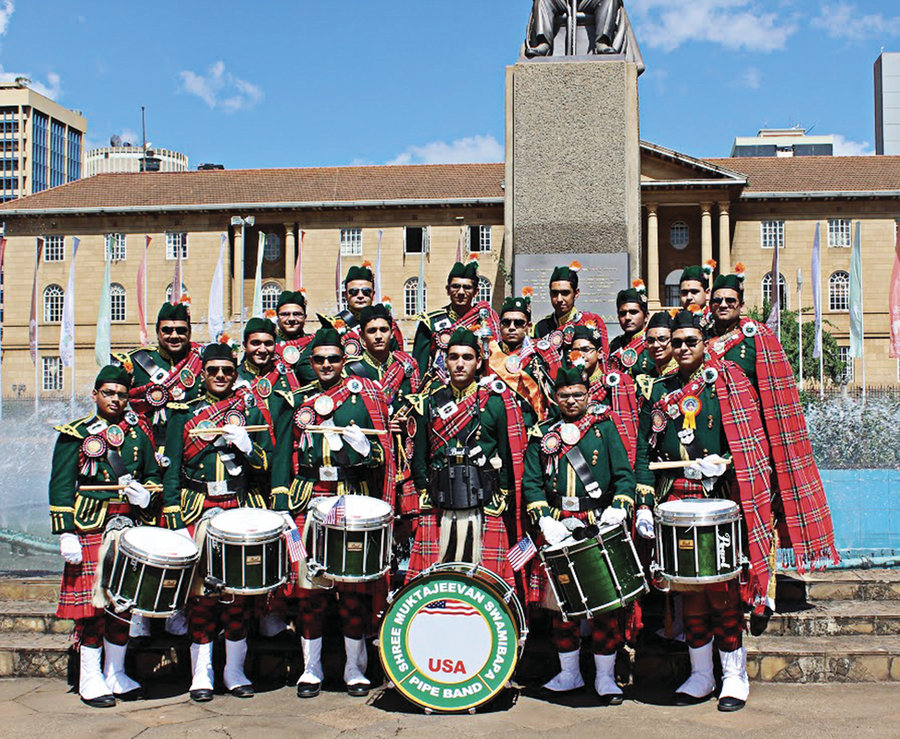It was a cross-cultural extravaganza as poor villagers crowded the streets of an African boom town to watch Indian performers from around the globe – including from a Secaucus temple – playing local tunes on bagpipes while marching in traditional Scottish highland garb. The garb included plaid kilts, garters, and furry head gear.
“Basically the whole town came out,” said band member Hersh Patel about the delighted spectators. “These people obviously don’t have many sources of entertainment. They can’t go after the parade to turn on the television and watch the news or sports. The joy that we saw from performing there was obviously different from what we see in New York.”
The parade through the village of Narok, Kenya was one of numerous stops for the Swamibapa Pipe Band, an international assemblage of bagpipe players, including 31 members of the Shree Swaminarayan Temple in Secaucus.
The Swamibapa Pipe Band has branches in numerous countries. Secaucus is home to the first U.S. chapter, founded in 2003. Other bands have cropped up subsequently across the U.S. as a sort of “minor league,” according to Patel.
Each year the bands celebrate in their own countries on the anniversary of the founding of the Shree Swaminarayan Temple. This year, in honor of the 60th anniversary of the founding of the Nairobi chapter of the band, five chapters arranged to send members to Africa to celebrate together by holding a five-day-long festival in the presence of Acharya Shree Swamishree Maharaj, successor to the band’s founder.
“The joy that we saw from performing there was obviously different from what we see in New York.” – Hersh Patel
____________
A 10-mile parade
About half the members of the Secaucus band joined the event in Africa, each paying their own way.
“We don’t really get to travel much as a group this large,” said Patel, serving as spokesman for the temple. “There were a lot of people from different professions, including students and working people.”
The festivities began with an opening celebration in Nairobi, featuring a documentary on the different bands and their global impact. Included were scenes of the Secaucus chapter with their strong community support at events like the local Memorial Day parade and 9/11 remembrance, as well as their performance in Madison Square Garden when Indian Prime Minister Narendra Modi visited the United States in 2014.
The London band was shown performing at a fundraiser in Wembley Stadium, and playing on street corners to raise money for charity.
One major highlight of the trip was the 500-person parade through Nairobi, featuring the five international bands, numerous floats, and other performers.
“It was about 10 miles long and it went through the whole downtown district of Nairobi and back to the temple,” said Patel. “Besides the band there were other groups of dancers and people chanting. It was pretty different, with all local community people involved in the parade also.”
The Nairobi portion of the trip included a cultural night for the participants, filled with singing, dancing, and skits, before the group headed to Masai Mara, a wildlife preserve where all 160 members went on a jungle safari in jeeps.
“We saw animals roaming around freely in their natural environment,” recalled Patel. The safari was intended to promote fellowship among the band members. “That was more about team building and unity than anything else.”
International celebrations
The trip was planned and organized by temple members living in Africa. “There’s a large Indian community in Africa,” explained Patel. “They first began migrating to Africa in the late 20s and early 30s. Basically what ended up happening was they couldn’t find work in India and the construction industry was booming in Africa. They saw opportunity.”
Muktajeevan Swamibapa, after whom the band is named, was the first “sant,” or monk, of the Swaminarayan religion to set foot on foreign soil in April 1948. He established in Nairobi the first Swaminarayan Gadi Temple outside of India.
The temple then spread to other countries, as did chapters of the pipe band. In 2007 members of various bands from around the globe got together in India to celebrate Swamibapa’s 100th birthday. “That was the last time this many people got together in one place from this many regions,” said Patel. But the Kenya trip brought out even more participants.
Upcoming for the group is another gathering in September to celebrate the 25th anniversary of the opening of Shree Muktajeevan Swamibapa Smruti Mandir in India, a marble temple build in memory of Swamibapa. All five bands plan to send members to perform together at the celebration.
Art Schwartz may be reached at arts@hudsonreporter.com.
